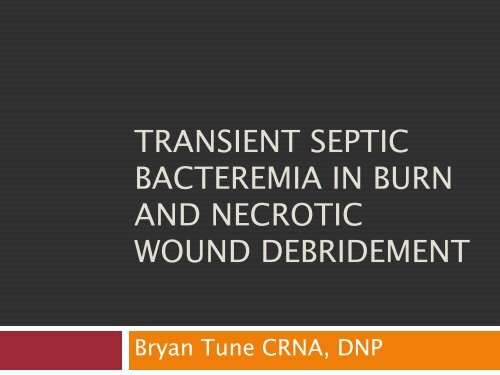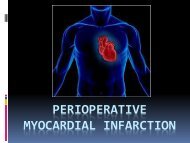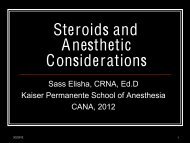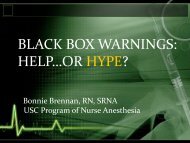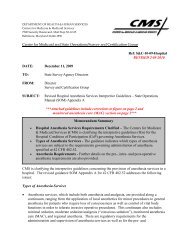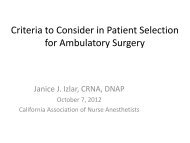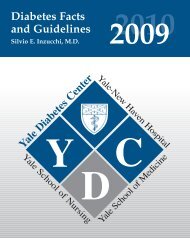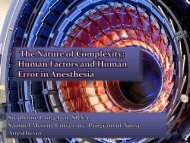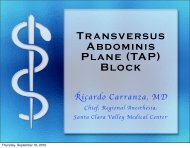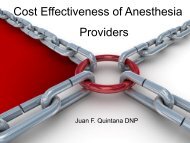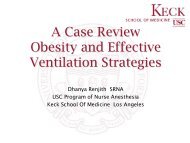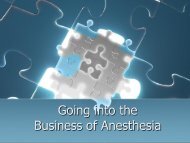Transient Septic Bacteremia in Burn and Necrotic Wound Debridement
Transient Septic Bacteremia in Burn and Necrotic Wound Debridement
Transient Septic Bacteremia in Burn and Necrotic Wound Debridement
- No tags were found...
Create successful ePaper yourself
Turn your PDF publications into a flip-book with our unique Google optimized e-Paper software.
TRANSIENT SEPTICBACTEREMIA IN BURNAND NECROTICWOUND DEBRIDEMENTBryan Tune CRNA, DNP
Objectives Identify patient populations that are athigh risk for <strong>Transient</strong> <strong>Septic</strong> <strong>Bacteremia</strong> Discuss Pathophysiology of <strong>Septic</strong><strong>Bacteremia</strong> Review the cl<strong>in</strong>ical signs <strong>and</strong> symptomsobserved dur<strong>in</strong>g <strong>Transient</strong> <strong>Septic</strong><strong>Bacteremia</strong>. Discuss treatment <strong>and</strong> patientstabilization.
<strong>Transient</strong> <strong>Septic</strong> <strong>Bacteremia</strong> –AKA: Also referred to <strong>in</strong> the literature as: <strong>Transient</strong> Endotoxemia Sepsis Toxic Shock Syndrome TSS Shooter’s fever
What is <strong>Transient</strong> <strong>Septic</strong><strong>Bacteremia</strong> A septic “storm” or bacterial showerdur<strong>in</strong>g tissue manipulation of burn orwound debridement Classic sepsis presentation, however itoccurs <strong>in</strong> a matter of seconds. Cytok<strong>in</strong>emediated. Quick <strong>and</strong> effective treatment required
Brief Pathophysiology Pro<strong>in</strong>flammatory response to <strong>in</strong>fection Mediators• TNF Alpha, IL-1, IL-6• Complement system (C5 alpha)• Bacterial factors• Endotox<strong>in</strong>, bacterial cell wall products, bacterialtox<strong>in</strong>s Immunosuppressive
TSB Pathophysiology Cont<strong>in</strong>ued: TSB occurs as a result of a “BacterialShower” Bacterial colonies are released <strong>in</strong>to thevascular system. Common: (Staph groupA <strong>and</strong>/or Clostridium) Endotox<strong>in</strong>s <strong>and</strong> cytok<strong>in</strong>es are immediatelyreleased caus<strong>in</strong>g the classic sepsis picture TNF Histam<strong>in</strong>e Bradyk<strong>in</strong><strong>in</strong>
Time-course of <strong>in</strong>flammatory response dur<strong>in</strong>gsepsis(modified from Management of Severe Sepsis <strong>and</strong> <strong>Septic</strong> Shock. Curr Op<strong>in</strong> Crit Care 2004;10:354-363)
<strong>Transient</strong> <strong>Septic</strong> <strong>Bacteremia</strong><strong>Burn</strong>s T.S.B. can occur dur<strong>in</strong>g debridement ofburn wounds (usually not seen dur<strong>in</strong>g<strong>in</strong>itial burn debridement) Common <strong>in</strong> large deep 2 nd <strong>and</strong> 3 rd degreeburn tissue excision <strong>Burn</strong> tissue (non-viable) is a growthmedium for bacteria Early debridement <strong>and</strong> allograft<strong>in</strong>g? <strong>Debridement</strong> <strong>and</strong> antimicrobial dress<strong>in</strong>gs
TSB Also Found In: Large necrotic wound Necrotiz<strong>in</strong>g Fasciitis Necrotiz<strong>in</strong>g soft tissue wounds Fournier’s Gangrene Gastro<strong>in</strong>test<strong>in</strong>al surgical procedures <strong>Burn</strong>s
Necrotiz<strong>in</strong>g Fasciitis
Necrotiz<strong>in</strong>g Fasciitis Soft tissue <strong>in</strong>fection that primarily affectssuperficial fascia Commonly found <strong>in</strong> IVDA <strong>and</strong> “Sk<strong>in</strong>Popp<strong>in</strong>g” Higher <strong>in</strong>cidence <strong>in</strong> patients with poorlycontrolled diabetes Diagnosed by cl<strong>in</strong>ical exam, CT, <strong>and</strong>/ortissue biopsy
Necrotiz<strong>in</strong>g Fasciitis (NF) Type 1 A mixed <strong>in</strong>fection caused by aerobic <strong>and</strong>anaerobic bacteria. These occur mostcommonly after surgery or <strong>in</strong> <strong>in</strong>dividuals withdiabetes <strong>and</strong> peripheral vascular disease. Type 2 A monomicrobial <strong>in</strong>fection caused primarilyby group A streptococcus (GAS), although itis occasionally caused by communityassociatedmethicill<strong>in</strong>-resistantStaphylococcus aureus (MRSA)
Cl<strong>in</strong>ical Presentation of N.F. Diffuse swell<strong>in</strong>g Erythema Extreme pa<strong>in</strong> Frequently no dra<strong>in</strong>age is observed Subcutaneous gas on C.T. <strong>and</strong>/or xray
Cl<strong>in</strong>ical signs <strong>and</strong> symptoms Acidosis Respiratory failure Low SVR High C/O Can progress to MODs Arrest
Necrotis<strong>in</strong>g Fasciitis of neck<strong>and</strong> chest as a result of IVDA
Risk Factors for NF Conditions associated with necrotiz<strong>in</strong>g vs.non-necrotiz<strong>in</strong>g <strong>in</strong>fections Drug use Diabetes mellitus (present <strong>in</strong> up to 60% ofcases) Obesity Immunosuppresion Malnutrition HIV <strong>in</strong>fection Alcoholism
Diagnosis of NF- Labs Interpretation of Risk Score > 6 should raise suspicion of NF > 8 is highly predictive of NF (75-80% <strong>in</strong> onestudy with NF had scores over 8)
Morbidity <strong>and</strong> Mortality Near 30% mortality with earlydetection/treatment Near 90% mortality with late <strong>in</strong>tervention Repeated surgical debridement also greatly<strong>in</strong>creases M/M Factors that <strong>in</strong>crease mortality: Truncal <strong>in</strong>volvement Diabetes Extremes of Age Anorectal Involvement
Causative Bacteria MRSA Group A Step Staph aureus Vibrio vulnificus Clostriduim
Fournier’s Gangrene Necrotiz<strong>in</strong>g Fasciitis of gro<strong>in</strong> <strong>and</strong>per<strong>in</strong>eum Found most common <strong>in</strong> patients withdiabetes <strong>and</strong> obesity Treatment is identical to necrotiz<strong>in</strong>gfasciitis <strong>in</strong> that extensive debridement <strong>and</strong>ABX therapy is the only def<strong>in</strong>itivetreatment
Fournier’s Gangrene
SepsisAll patients with severe sepsis require appropriateantimicrobial agents immediately <strong>and</strong> physiologicsupportive therapy.Antimicrobial therapy is often an empiric choicebecause of the time required for culture <strong>and</strong>sensitivity results. Larger spectrum, unless there is strong suspicion of theorganismMany patients do not have a pathogen identified.Empiric antifungal therapy is necessary <strong>in</strong> somecases.
More than 90 % of cases are caused by amonomicrobial <strong>in</strong>fection.Possible gram-negative pathogens <strong>in</strong>clude: Escherichia coli (40%) Klebsiella pnemoniae (7%) Pseudomonas species Proteus species Gram-positive organisms (e.g. streptococcus pneumoniae(15%)
Anaerobic microorganisms arefound <strong>in</strong> less than 5% of cases-RE: superficial colonization.Multiple isolates are found <strong>in</strong>less than 10%
Management Antibiotic therapy: Should be composed of triple therapy ifMRSA can not be ruled out:• Pen G• Vancomyc<strong>in</strong>• Cl<strong>in</strong>damyc<strong>in</strong>
Antibiotic Therapy
Cl<strong>in</strong>ical Management:Preoperative metabolic status evaluationEvaluate preoperatively the need for Arterial BPmonitor<strong>in</strong>g- Likely <strong>and</strong> central venous access.Need to anticipate potential for large volume bloodloss.Assure optimum venous access for fluid resuscitation Central l<strong>in</strong>e CVP monitor<strong>in</strong>g Large fluid resuscitation requirements• Utiliz<strong>in</strong>g Early Directed Goal TherapyFoley Catheter
Cl<strong>in</strong>ical Management: Symptom <strong>and</strong> systems driven….*EARLY GOAL DIRECTED THERAPY* ABC’s Treat hypotension (fluids, blood products,vasopressors) Removal of contam<strong>in</strong>ated tissue source bysurgeon. <strong>Debridement</strong> can result <strong>in</strong>massive amounts of tissue excision beforehealthy tissue is reached
Intra-Operative Cl<strong>in</strong>icalManagementLarge fluid resuscitation with crystalloid <strong>and</strong>colloid• Can be 10-20 liters per day• Consider Plasma-lyte (lactate free) vs LREvaluate need for post-op ventilation with serialABG <strong>and</strong> metabolic panels dur<strong>in</strong>g caseBase excess can be a useful predictor ofsuccessful fluid resuscitationKeep HCT at or above 24 to help optimize<strong>in</strong>travascular drag coeffient <strong>and</strong> tissue perfusion.Identify coagulopothy- very likely (FFP <strong>and</strong> Cryo). ROTEM- Rotational Thromboelastometry??
Intra-operative Cl<strong>in</strong>icalManagement-Vasopressors- Vasopressor therapy may be required for endorgan perfusion Consider Vasopress<strong>in</strong>: Evaluate appropriateness of Vasopress<strong>in</strong> <strong>in</strong>fusionfor V2 receptor stimulation <strong>and</strong> splanchnicvascular contraction Does not affect coronary blood flow Can be used alone or with other catecholam<strong>in</strong>es Infusion rate: 0.04 units per hour as a constant• Not titrated. First vasopressor on <strong>and</strong> last off.
Intra-operative Cl<strong>in</strong>icalManagement:-Vasopressors- Norep<strong>in</strong>ephr<strong>in</strong>e (Levophed) <strong>in</strong>fusion Improves <strong>and</strong>/or ma<strong>in</strong>ta<strong>in</strong>s MAP >60 Improves LVEDF Increases SVR Some recent data shows coronary arterydilation <strong>and</strong> <strong>in</strong>crease myocardial perfusion Infusion dos<strong>in</strong>g: 1-50 mcg/m<strong>in</strong>. Titrated toSystolic <strong>and</strong> MAP.
Intraoperative TSB Management Ep<strong>in</strong>ephr<strong>in</strong>eBacteremic storm can be so significant Ep<strong>in</strong>ephr<strong>in</strong>emay be required Mast cell stabilization Histam<strong>in</strong>e response from histam<strong>in</strong>e <strong>and</strong>bradyk<strong>in</strong><strong>in</strong> release from bacterial storm Emergency resuscitation for extremehypotension with ensu<strong>in</strong>g bradycardia. 5-10 mcg bolus may be required, followedby an <strong>in</strong>fusion of 1-20 mcg/m<strong>in</strong>.
Adrenal Insufficiency The <strong>in</strong>cidence of adrenal <strong>in</strong>sufficiency <strong>in</strong> sepsisapproximately 30-70% Def<strong>in</strong>ed as hypotension resistant to volumeresuscitation <strong>and</strong> dependent on vasopressors Annane, 2002 demonstrated that steroidsimprove mortality <strong>in</strong> patients with septic shock<strong>and</strong> adrenal <strong>in</strong>sufficiency Mortality is more than double that of patientswith abnormal adrenal responsiveness hyponatremia, hyperkalemia, weakness, <strong>and</strong>hyperpigmentation not specific enough <strong>in</strong> ICUsett<strong>in</strong>g
Cosyntrop<strong>in</strong> Stim. Test<strong>in</strong>g (ACTH) In the study by Annane, adrenal<strong>in</strong>sufficiency was def<strong>in</strong>ed as an <strong>in</strong>crease <strong>in</strong>total cortisol < 9 mcg/dL <strong>in</strong> response to a250 mcg Cosyntrop<strong>in</strong> Stimulation Test This formed the basis for current practiceof treat<strong>in</strong>g patients with septic shock <strong>and</strong>adrenal <strong>in</strong>sufficiency with stress dosesteroids
Steroid Dos<strong>in</strong>g Stress dos<strong>in</strong>g with hydrocortisone forpotential adrenal suppression (doses>300mg strongly discouraged <strong>in</strong> theliterature) Typical dos<strong>in</strong>g of 50-100mg Bicarbonate Increase pH Improve vasopressor response <strong>in</strong> severeacidosis patient
Nutritional SupportFor cl<strong>in</strong>icians car<strong>in</strong>g for critically ill patients, thegoal of nutrition support has been to deliver 100%of nutrient requirements, calculated for the specificmetabolic condition, <strong>in</strong> the shortest time possible.Recently, cl<strong>in</strong>ical experts <strong>in</strong> <strong>in</strong>tensive care medic<strong>in</strong>e<strong>and</strong> nutrition <strong>and</strong> published studies <strong>in</strong> the medicalliterature have determ<strong>in</strong>ed that for critically illpatients, adm<strong>in</strong>ister<strong>in</strong>g nutrients at quantities lessthan a calculated metabolic expenditure maysignificantly improve outcomes.
<strong>Transient</strong> <strong>Septic</strong> <strong>Bacteremia</strong>Case Study 48 year old male- Scheduled for debridement<strong>and</strong> completion amputation of right leg. PMHX: IVDA, Hep-C, HTN, DM- poorlycontrolled, smoker, ETOH PSHX: Multiple abscess I&D’s, Left toeamputation, facial laceration repair, RightAKA. Social HX: Homeless, IVDA, Poor nutrition,limited resources, non-compliant with DMregimen. Admitted through ED with a-vascular leg with maggot <strong>in</strong>festation.
Preop: Case Study VS: BP- 91/40 HR: 138 Temp: 39.5 SpO2- 93% - 2 liters NC Diaphoretic Pert<strong>in</strong>ent Lab Values: WBC- 68,000, HgB- 9.2, Lactate- 4, pH-7.22, Base Deficit- (-12).•OMG!
Case Study Preoperatively 2 liters of LR were rapidly<strong>in</strong>fused prior to transport to OR. Consent: GETA Al<strong>in</strong>e- (Placed preop under local) Central L<strong>in</strong>e- Subclavian vs. IJ (placement afterGETA) Blood Products Postoperative Ventilation
Intraoperative: Induction: Midazolam 2mg Fentanyl 50mg Amidate 16mg (best choice???) Succ<strong>in</strong>ylchol<strong>in</strong>e: 100mg Sevoflurane for ma<strong>in</strong>tance Fluid bolus<strong>in</strong>g cont<strong>in</strong>ued through <strong>in</strong>duction<strong>and</strong> dur<strong>in</strong>g the course of the procedure.
Case Study: Intraoperative Surgical excision of necrotic tissue – pungentodor VSS with fluid bolus<strong>in</strong>g <strong>in</strong> place at start ofprocedure. With<strong>in</strong> 10 m<strong>in</strong>utes of surgical debridement<strong>and</strong> excision of right leg the patient began todecompensate quickly: HR- 150s BP- 79/40Neosynephr<strong>in</strong>e bolus dos<strong>in</strong>g at 100mcg everym<strong>in</strong>ute needed to ma<strong>in</strong>ta<strong>in</strong> blood pressure
Intraoperative: Vasopress<strong>in</strong> <strong>in</strong>fusion <strong>in</strong>itiated: 0.4 units perm<strong>in</strong> Levophed Infusion <strong>in</strong>itiated: 20mcg/m<strong>in</strong> Despite aggressive <strong>and</strong> rapid <strong>in</strong>itiation ofvasoactive drips <strong>and</strong> fluid bolus<strong>in</strong>g thepatient cont<strong>in</strong>ued to decompensate. BP cont<strong>in</strong>ued to drop <strong>in</strong>to the 50’s systolic HR- 160s Unresponsive to Neosynephr<strong>in</strong>e doses 2 Amps of Bicarb adm<strong>in</strong>istered Ep<strong>in</strong>ephr<strong>in</strong>e 100mcg bolus x3
Intraoperative Bicarbonate <strong>in</strong>fusion <strong>in</strong>itiated Levophed <strong>in</strong>creased to 40mcg/m<strong>in</strong> 1 unit PRBC 3 Units FFP Album<strong>in</strong> <strong>in</strong>fusion Hydrocortisone 100mg IV
Case Study- Repeat labs sent after stabilization- Pt rema<strong>in</strong>ed <strong>in</strong>tubated <strong>and</strong> transported toPACU- Lab results: INR 2.1, HCT- 34, WBC-92,- ABG: pH: 7.21, CO2- 39, PO2- 160, BE- (-10)- *8 hours later nurs<strong>in</strong>g staff turned pt on side fordress<strong>in</strong>g change <strong>and</strong> pt went <strong>in</strong>to PEA. ACLSunsuccessful.
<strong>Transient</strong> <strong>Septic</strong> <strong>Bacteremia</strong>ReviewCommon <strong>in</strong> burn wound debridement <strong>and</strong>necrotic wound debridement (AKA’s, BKA,Arm amputations)Goal directed resuscitation(ventilation, fluids, blood, vasopressors,ABX)M<strong>in</strong>imally <strong>in</strong>vasive C/O monitor<strong>in</strong>g (vigileo?)-(pulse pressure variance).Post Op: Isolation, may require ventilatorsupport, sedation, vasopressors, <strong>and</strong>cont<strong>in</strong>ued resuscitation <strong>in</strong> PACU/ICU
Lunch??Questions?


